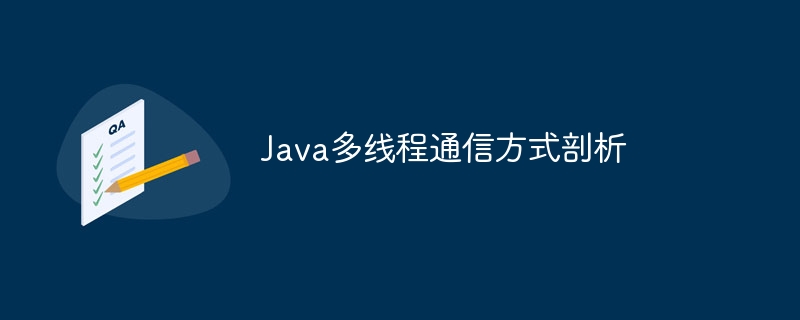Home >Java >javaTutorial >Analysis of Java multi-threaded communication methods
Analysis of Java multi-threaded communication methods
- WBOYWBOYWBOYWBOYWBOYWBOYWBOYWBOYWBOYWBOYWBOYWBOYWBOriginal
- 2024-04-12 08:18:01452browse
In Java, multi-thread communication methods include shared variables, wait/notify, semaphores and pipes. Shared variables facilitate data exchange but are prone to concurrency issues; wait/notify uses a synchronization mechanism to wait and wake up between threads; semaphores limit the number of threads accessing resources at the same time; pipes use buffers to transfer data between threads.

Analysis of Java multi-thread communication methods
Introduction
Multi-threading is concurrency An important concept in programming that allows multiple tasks to be performed simultaneously. In order to implement data exchange in a multi-threaded environment, we need to understand various communication methods. This article will take an in-depth look at common multi-threaded communication methods in Java, including shared variables, wait/notify, semaphores, and pipes.
Shared variables
Shared variables are global variables that can be accessed by multiple threads. When one thread modifies a shared variable, other threads can see the changes. However, shared variables are prone to concurrency problems, such as race conditions and unpredictable behavior.
Practical case:
public class SharedVariableExample {
private static int sharedCounter = 0;
public static void main(String[] args) throws InterruptedException {
Thread thread1 = new Thread(() -> {
for (int i = 0; i < 1000; i++) {
sharedCounter++;
}
});
Thread thread2 = new Thread(() -> {
for (int i = 0; i < 1000; i++) {
sharedCounter--;
}
});
thread1.start();
thread2.start();
thread1.join();
thread2.join();
System.out.println("最终共享计数器:" + sharedCounter);
}
}wait/notify
wait/notify is a built-in synchronization mechanism in Java. The wait() method will put the current thread into a waiting state until other threads call the notify() or notifyAll() method to wake it up.
Practical case:
public class WaitNotifyExample {
private static Object lock = new Object();
private static boolean dataAvailable = false;
public static void main(String[] args) throws InterruptedException {
Thread producer = new Thread(() -> {
synchronized (lock) {
while (!dataAvailable) {
try {
lock.wait();
} catch (InterruptedException e) {
e.printStackTrace();
}
}
System.out.println("处理数据...");
}
});
Thread consumer = new Thread(() -> {
synchronized (lock) {
dataAvailable = true;
lock.notify();
}
});
producer.start();
consumer.start();
producer.join();
consumer.join();
}
}Semaphore
The semaphore is a synchronization mechanism that allows a specific number of threads Access a resource at the same time. When a thread acquires a semaphore, the semaphore counter is decremented; when it releases the semaphore, the counter is incremented.
Practical case:
public class SemaphoreExample {
private static Semaphore semaphore = new Semaphore(2);
public static void main(String[] args) throws InterruptedException {
Thread thread1 = new Thread(() -> {
try {
semaphore.acquire();
System.out.println("线程 1 进入临界区");
} catch (InterruptedException e) {
e.printStackTrace();
} finally {
semaphore.release();
}
});
Thread thread2 = new Thread(() -> {
try {
semaphore.acquire();
System.out.println("线程 2 进入临界区");
} catch (InterruptedException e) {
e.printStackTrace();
} finally {
semaphore.release();
}
});
thread1.start();
thread2.start();
thread1.join();
thread2.join();
}
}Pipeline
Pipeline is a special data structure used for communication between threads. It's like a buffer, one thread can write data and another thread can read data.
Practical case:
public class PipeExample {
private static PipedOutputStream pos = new PipedOutputStream();
private static PipedInputStream pis = new PipedInputStream(pos);
public static void main(String[] args) throws IOException {
Thread writer = new Thread(() -> {
try {
pos.write("你好,世界!".getBytes());
} catch (IOException e) {
e.printStackTrace();
} finally {
pos.close();
}
});
Thread reader = new Thread(() -> {
try {
byte[] data = new byte[1024];
int length = pis.read(data);
System.out.println(new String(data, 0, length));
} catch (IOException e) {
e.printStackTrace();
} finally {
pis.close();
}
});
writer.start();
reader.start();
writer.join();
reader.join();
}
}The above is the detailed content of Analysis of Java multi-threaded communication methods. For more information, please follow other related articles on the PHP Chinese website!
Related articles
See more- Java multi-threading to achieve simultaneous output
- Recommended videos and information on the development of advanced applications of Java multi-threading and concurrency libraries
- What is the use of multithreading for games?
- Several ways to implement multithreading in java
- Research on concurrency and synchronization mechanism in Golang distributed system

